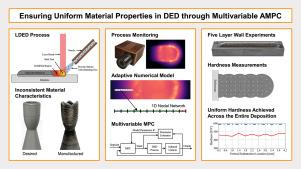Real-time multivariable control of directed energy deposition via adaptive model predictive control
IF 11.1
1区 工程技术
Q1 ENGINEERING, MANUFACTURING
引用次数: 0
Abstract
Additive manufacturing processes such as directed energy deposition (DED) enable precise material deposition and customization, but ensuring consistent material properties remains a challenge due to the complex interplay of process parameters. This research presents a novel adaptive model predictive control (AMPC) algorithm for real-time multivariable control in DED, integrating an adaptive one-dimensional thermal model for accurate prediction of both temperature distribution and spatial cooling rate. The model was experimentally validated in single-track deposition tests across four different materials, achieving temperature predictions within ±1% of infrared camera measurements and spatial cooling rate errors below 2.73%. The validated model was embedded within the control framework and evaluated in five-layer wall experiments under open-loop, single-input single-output (SISO), and multi-input multi-output (MIMO) closed-loop control configurations. Results demonstrate that the AMPC algorithm effectively stabilized melt pool dynamics through simultaneous control of laser power and traveling speed, leading to consistent layer heights and improved material uniformity. This work introduces a scalable, adaptive, physics-based framework for real-time thermal prediction and multivariable control in advanced manufacturing processes that use concentrated energy sources, improving melt pool stability, material consistency, and overall part quality.

基于自适应模型预测控制的定向能沉积实时多变量控制
定向能沉积(DED)等增材制造工艺可以实现精确的材料沉积和定制,但由于工艺参数的复杂相互作用,确保材料性能的一致性仍然是一个挑战。本文提出了一种新的自适应模型预测控制(AMPC)算法,该算法集成了自适应一维热模型,可以准确预测温度分布和空间冷却速率。该模型在四种不同材料的单道沉积测试中得到了实验验证,温度预测误差在红外相机测量值的±1%以内,空间冷却速率误差低于2.73%。将验证模型嵌入到控制框架中,并在开环、单输入单输出(SISO)和多输入多输出(MIMO)闭环控制配置下的五层壁面实验中进行了评估。结果表明,AMPC算法通过同时控制激光功率和行进速度,有效地稳定了熔池动力学,使熔池层高度保持一致,提高了材料均匀性。这项工作引入了一个可扩展的、自适应的、基于物理的框架,用于在使用集中能源的先进制造过程中进行实时热预测和多变量控制,提高熔池稳定性、材料一致性和整体零件质量。
本文章由计算机程序翻译,如有差异,请以英文原文为准。
求助全文
约1分钟内获得全文
求助全文
来源期刊

Additive manufacturing
Materials Science-General Materials Science
CiteScore
19.80
自引率
12.70%
发文量
648
审稿时长
35 days
期刊介绍:
Additive Manufacturing stands as a peer-reviewed journal dedicated to delivering high-quality research papers and reviews in the field of additive manufacturing, serving both academia and industry leaders. The journal's objective is to recognize the innovative essence of additive manufacturing and its diverse applications, providing a comprehensive overview of current developments and future prospects.
The transformative potential of additive manufacturing technologies in product design and manufacturing is poised to disrupt traditional approaches. In response to this paradigm shift, a distinctive and comprehensive publication outlet was essential. Additive Manufacturing fulfills this need, offering a platform for engineers, materials scientists, and practitioners across academia and various industries to document and share innovations in these evolving technologies.
 求助内容:
求助内容: 应助结果提醒方式:
应助结果提醒方式:


